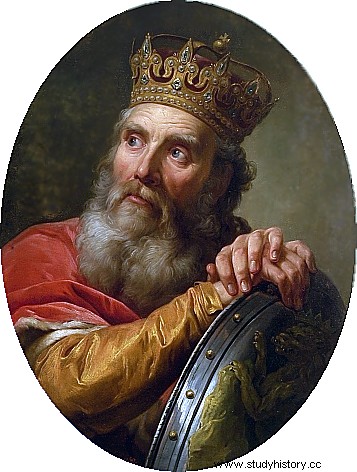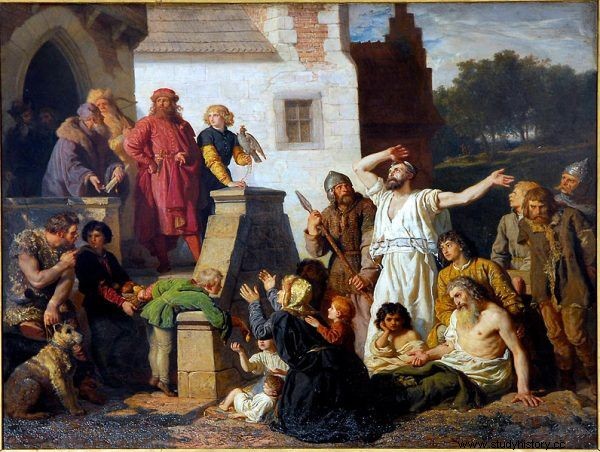The popular slogan is often repeated:"Casimir the Great found Poland wooden and left it bricked". How much truth is there? Did the ruler improve the condition of the country and how?
The longer we look at any historical figure, the more unfavorable facts begin to emerge. In the case of Casimir the Great it is similar, of course, but ... His image is difficult to slander unequivocally. He remains a ruler associated with progress, good politics and a full treasury. How did he do it?
As they write you, that's how they see you
According to Professor Jacek Maciejewski from the Kazimierz Wielki University in Bydgoszcz, the crystal image of the ruler is not a product of our times. Even during his reign, he attached great importance to what his subjects thought of him. “[...] he was already perceived by his contemporaries as an outstanding figure, an excellent landowner and a just ruler, compared to the biblical Solomon. Someone who ruled better than others, 'said Professor Maciejewski.

Casimir the Great from the post of Polish kings Marcello Bacciarelli
Flattering information about the king appeared, for example, in the arenas of the documents he issued. Symbolism was also of great importance - the famous "K" in the crown, which was a kind of brand. The sign has been preserved, among others, on the door of the Wawel cathedral and in the Augustinian church in Kraków. On the coins minted in Kazimierz's time there was an inscription "Kazimiri, regis Poloniae".
Progress and splendor during the rule of the last Piast could be seen at every step, thanks to the cultural knowledge of the king himself. He funded many gothic buildings and works of art. He completed the extension of the cathedral started by Władysław Łokietek and erected the famous tombstone for his father in it.
He commissioned a similar tombstone for Bolesław Chrobry in the Poznań cathedral - both tiles in line with the current trends in European sepulchral art. The series of sacred buildings funded by Kazimierz seem to be endless :rebuilt castle chapel of St. Mary of Egypt, Corpus Christi Parish, St. Catherine and Margaret with the Augustinian monastery in Kazimierz. Temples in Niepołomice, Stopnica, Sandomierz, Wiślica, Zagość, Kargów, Szydłów ... Certainly, the subjects of the good king saw that the country was going well.
How was that wall
But was it really the time of Casimir the Great that such powerful changes took place - not only demonstrative, but actually influencing the quality of life of an average country inhabitant?
Let's start with the proverbial cities that had en masse appear thanks to the actions of the king. And in fact, it was exactly like that:during his reign, about a hundred new cities were created, which in fact ended the urbanization process of Małopolska ... until the present day. Of course, not all of them were funded entirely from the royal treasury:Casimir the Great commissioned the demarcation of the boundaries of the emerging city, which excluded the ruling state from general property rights, serfdom and court. Investors could then build their sanctuaries in the indicated places, of course under an agreement with the ruler. This allowed for the dynamic development of urban centers, at the same time supplying the royal treasury.
After the reign of Kazimierz, many defensive structures also remained, which gave rise to a system of fortifications known as the Trail of the Eagles' Nests. Usually, this process involved the modernization of old wooden forts, which were rebuilt into brick ones. Usually, a church was also built in the area.
Apart from cities, churches and fortifications, villages developed and arose. Casimir the Great rightly predicted that a period of relief from the obligation to pay benefits is needed for the proper development of the community and the economy of agricultural and livestock areas. That is why the "free" was in force:the settlers who settled the newly established village for a fixed number of years did not have to pay taxes to the treasury.
Industry under Kazimierz
Taxes were still being levied that might have given rise to negative views about the king. The money was often collected as part of an extraordinary action, called a "collect", which irritated the subjects a lot (no wonder!). The standard tax was of course the so-called "Counseling", ie land tax, which was the greatest source of income for the treasury. However, in combination with the three-field cultivation that was introduced at that time (cultivation of two thirds of the agricultural area each year so that the remaining one third of the acreage could "rest") and investments from Kazimierz, such a system allowed for dynamic development and improvement of the situation of farmers.

Party of Jews, painting by Wojciech Gerson
The rational management of the salt mines was also important. Kazimierz established a working system of cooperation rules between the mines, the market and the treasury. The miners who leased the mine could sell the salt only on the spot, to merchants arriving for it, and only the city of Krakow could store the valuable mineral. Merchants from Kraków and Wieliczka had the opportunity to sell in Kraków, which earned both them, the saltworks and the king. Such a system was very profitable for all parties and - once again - allowed for development.
So it turns out that Casimir the Great combined the power of propaganda with actual deeds. He ran an efficient, modern management policy, while taking care of his image and the condition of his "account". He did not get into costly conflicts, instead building up working systems of internal organization. No wonder we still remember the king as, in fact, the Great.
